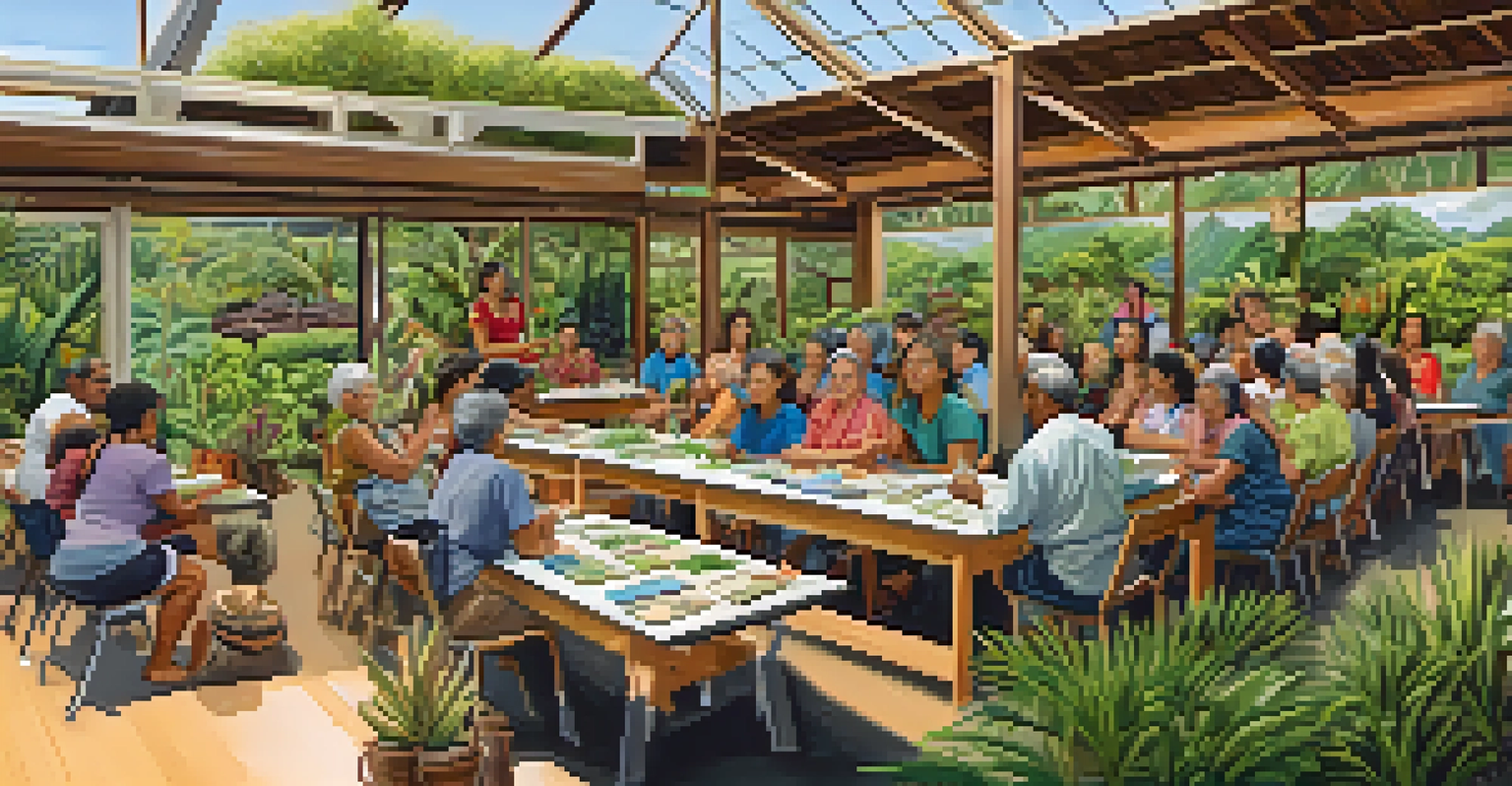Climate Adaptation Strategies for Hawaii's Vulnerable Communities

Understanding Climate Change Impacts on Hawaii
Hawaii is uniquely vulnerable to the effects of climate change, with rising sea levels, increased rainfall, and more intense storms threatening its diverse ecosystems and communities. For instance, coastal areas face erosion and flooding, which can displace residents and disrupt local economies. Additionally, changes in weather patterns can lead to droughts or flooding, impacting agriculture and water supply.
The greatest threat to our planet is the belief that someone else will save it.
The islands' geographical isolation also means that climate impacts can be more pronounced, as resources are limited. Vulnerable communities, particularly those with lower incomes or limited access to resources, often face the brunt of these changes. Understanding these impacts is the first step to developing effective adaptation strategies that can safeguard livelihoods and preserve the unique Hawaiian culture.
It's crucial for residents and policymakers alike to grasp the severity of these threats. By acknowledging the reality of climate change, communities can unite in their efforts to find sustainable solutions that not only protect the environment but also enhance resilience against future challenges.
Community Engagement: The Key to Effective Adaptation
One of the most effective ways to develop climate adaptation strategies is through community engagement. By involving local residents in the decision-making process, planners can ensure that the strategies reflect the actual needs and concerns of those who are most affected. Workshops, town hall meetings, and surveys can facilitate this dialogue, allowing community members to voice their experiences and suggestions.

For example, in some Hawaiian communities, local knowledge about traditional agricultural practices has been invaluable in shaping adaptation strategies that are culturally relevant and effective. When residents are engaged, they are more likely to support and implement the proposed solutions, leading to stronger community resilience. This collective approach helps foster a sense of ownership and accountability.
Community Engagement Drives Resilience
Involving local residents in climate adaptation planning ensures strategies are relevant and effective, fostering a sense of ownership and accountability.
Moreover, community engagement can build social capital, strengthening relationships among residents. When individuals work together toward common goals, they not only tackle the climate crisis but also enhance their social networks, making it easier to respond to future challenges.
Integrating Traditional Knowledge into Adaptation Plans
Hawaii's rich cultural heritage provides a wealth of traditional knowledge that can inform climate adaptation strategies. Indigenous practices, such as sustainable farming and water management techniques, have stood the test of time and offer valuable insights into living harmoniously with the environment. By integrating these practices into modern adaptation plans, communities can create solutions that are both effective and culturally appropriate.
We do not inherit the earth from our ancestors, we borrow it from our children.
For instance, the use of 'aloha aina,' or love for the land, emphasizes the importance of stewardship and sustainability. This philosophy encourages the community to take an active role in protecting their natural resources and adapting to environmental changes. By leveraging traditional knowledge, Hawaii's communities can develop strategies that are not only practical but also resonate with their cultural values.
Furthermore, this integration fosters intergenerational learning, allowing younger generations to appreciate and carry forward traditional practices. This not only strengthens community ties but also ensures that valuable knowledge is preserved for the future.
Sustainable Infrastructure: A Foundation for Resilience
Building sustainable infrastructure is crucial for enhancing community resilience against climate change. This includes investing in renewable energy sources, such as solar and wind, which can reduce dependency on imported fossil fuels and decrease greenhouse gas emissions. Moreover, transitioning to sustainable infrastructure creates jobs and stimulates the local economy, benefiting vulnerable communities.
For example, retrofitting existing buildings to be more energy-efficient not only lowers utility costs but also prepares them for extreme weather events. Constructing seawalls and restoring natural buffers like wetlands can protect coastal areas from flooding and erosion. These infrastructure improvements are essential for safeguarding lives and livelihoods.
Integrating Traditional Knowledge Matters
Utilizing indigenous practices and cultural values in adaptation strategies enhances their effectiveness and ensures they resonate with local communities.
Additionally, sustainable infrastructure can incorporate green spaces, which provide numerous benefits, from enhancing air quality to offering recreational areas for residents. By prioritizing these developments, Hawaii can create safer, healthier, and more resilient communities that are better equipped to face the challenges posed by climate change.
Education and Awareness: Empowering Communities
Education plays a pivotal role in empowering communities to adapt to climate change. By raising awareness about the impacts of climate change and the importance of adaptation strategies, residents can make informed decisions that benefit themselves and their environment. Schools, community organizations, and local governments can collaborate to create educational programs that address these issues.
For instance, workshops on sustainable practices, such as rainwater harvesting or native plant gardening, can equip community members with the skills they need to adapt. Moreover, integrating climate education into school curricula ensures that future generations are prepared to tackle these pressing challenges. This foundational knowledge fosters a culture of sustainability and resilience.
Community awareness campaigns can also promote individual actions that contribute to larger goals. When residents understand how their choices impact the environment, they are more likely to adopt sustainable habits, creating a ripple effect that strengthens community resilience.
Policy Support: Creating a Framework for Action
Robust policy support is essential for implementing effective climate adaptation strategies. Local and state governments must prioritize climate resilience in their planning and development processes, ensuring that vulnerable communities receive the resources and support they need. This can include funding for infrastructure projects, research initiatives, and community engagement efforts.
For example, policies that incentivize sustainable building practices or support local farmers in adopting climate-resilient crops can have a significant impact. Additionally, integrating climate adaptation into land-use planning can help mitigate future risks, promoting smart development that protects both the environment and the community's well-being.
Education Empowers Sustainable Action
Raising awareness and providing education on climate impacts equips communities with the knowledge needed to adapt and promote sustainable practices.
Furthermore, creating partnerships between government agencies, non-profits, and local organizations can enhance the effectiveness of adaptation efforts. By working together, these entities can share resources, knowledge, and best practices, leading to a more comprehensive approach to climate resilience.
Measuring Success: Evaluating Adaptation Strategies
To ensure the effectiveness of climate adaptation strategies, it's essential to establish metrics for success and regularly evaluate their impact. This process involves collecting data on various indicators, such as community engagement levels, economic resilience, and environmental health. By analyzing this data, communities can assess what is working and identify areas for improvement.
For instance, tracking the reduction in flood damage or the increase in local food production can demonstrate the effectiveness of specific adaptation initiatives. This evidence-based approach allows policymakers to make informed decisions about future investments and adaptations.

Moreover, sharing success stories and lessons learned with other communities can inspire collective action and innovation. By fostering a culture of continuous improvement, Hawaii's vulnerable communities can become beacons of resilience, showcasing the power of collaboration and proactive adaptation in the face of climate change.